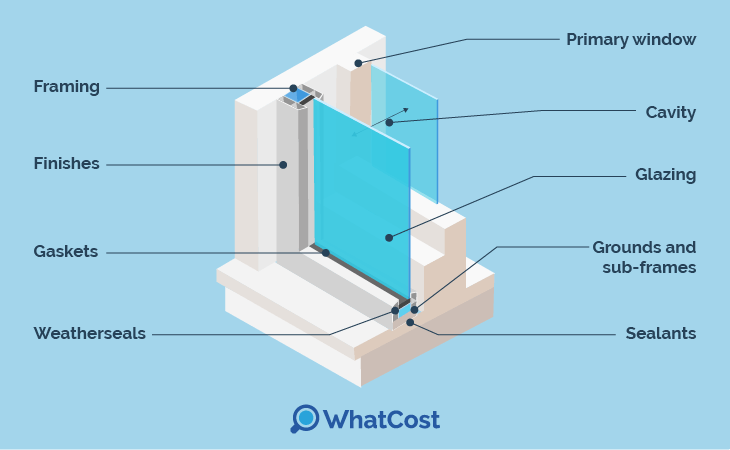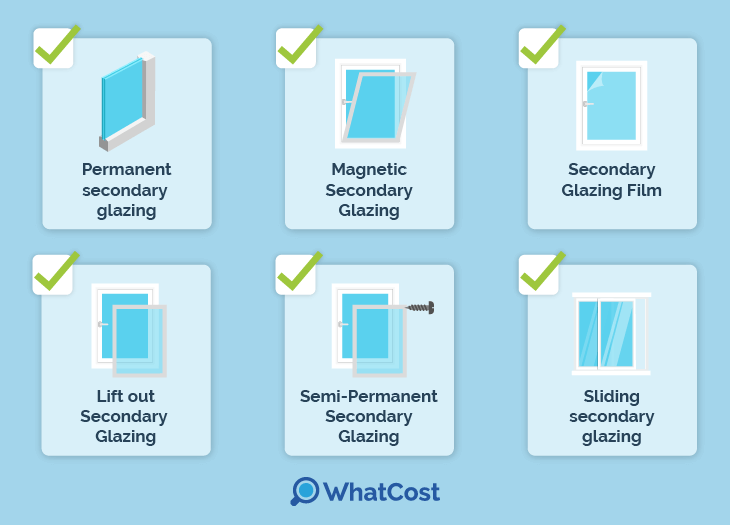Answer these simple questions and we will find you the BEST prices
Which type of solar quotes do you need?
It only takes 30 seconds
100% free with no obligation

Get up to 4 quotes by filling in only 1 quick form

Compare quotes and find yourself the best deal

Increase the value of your home by installing new windows
- whatcost.co.uk
- Windows
- Secondary Glazing
Secondary Glazing in the UK: Costs, Installation, & Benefits (2025)


- The average cost for secondary glazing is between £150 and £350 per window, although some types can be as cheap as £15.
- Prices can vary based on the type of glazing and whether you hire an installer.
- Types of secondary glazing include magnetic, glazing film, temporary, and semi-permanent secondary glazing.
- The biggest advantages of secondary glazing are that it is the cheapest form of glazing and can be easily added or removed.
While double glazing is standard for most homes, it may not always be an option. However, other options, like secondary glazing, can be a great alternative in a pinch. It is also easier to remove, making it a good temporary installation. But will the lower efficiency, quality, and lifespan be worth it?
Let’s dive deeper into this and go over when secondary glazing is worth installing and when it’s not.
If you’re looking to upgrade your glazing and need some more in-depth advice, it’s best to ask a reliable installer. While articles like this can be a great guide, an installer will be able to observe your home and give you tailored recommendations. However, finding a good one can be a time-consuming process that takes hours of research and calling up companies. That’s why our service is a quicker, easier alternative.
Simply fill out a 30-second form, and we’ll respond with up to 4 free quotes, with no payment obligation. Click the button below to gain access to our extensive network of vetted installers.
- Quotes from local installers
- Payment by finance available
- Save up to £150 per year
It only takes 30 seconds

What is secondary glazing?
Secondary glazing is a window insulation method that applies another layer on top of an existing one to improve energy efficiency. Unlike double glazing, this is added to a pre-installed window and is often easy to remove (and potentially temporary).

Secondary glazing can be temporary, semi-permanent, or even a permanent attachment. It adds a frame and seal to the primary window from the inside, allowing for better energy efficiency, insulation, and noise reduction. While it is not as strongly sealed or as efficient as double glazing, it can be easier and cheaper to implement.
The types of sealant and attachment features can vary depending on how permanent the glazing needs to be. Some are easily removable, while others may require a bit of handiwork. Regardless, secondary glazing is a far less expensive or extreme measure. The secondary windows and insulation elements allow for better savings than standard single glazing, but not as much as double or triple glazing.
Secondary glazing cost in the UK
The cost of secondary glazing varies between £60 and £700, depending on the chosen method. It also provides different savings, with fixed secondary glazing being the most energy-efficient.
| Secondary glazing type | Glazing kit cost | Annual savings |
|---|---|---|
| Sliding secondary glazing | £60 - £200 | £60 |
| Magnetic secondary glazing | £25 - £200 | £40 |
| Lift-out secondary glazing | £200 - £400 | £60 |
| Fixed secondary glazing | £200 - £700 | £70 |
| Secondary glazing film | £15 - £80 | £40 |
Secondary glazing can decrease heat loss by 30% to 60%, but is 30% to 50% less efficient than double glazing at decreasing energy bills. Less permanent forms of glazing with less thermally efficient materials are on the lower end of the spectrum. Secondary glazing prices also vary based on whether you are installing it yourself or hiring a professional.
Government grants for improving windows do not apply to secondary glazing. However, there are numerous double glazing grants, like the ECO4 scheme, that can help upgrade single glazed windows to double.
Secondary glazing installation cost
So, how much does secondary glazing cost to install? Installer rates can vary between £15 and £30 per. Secondary glazing is easy to apply to a single window, usually taking 1 to 2 hours. If you need to add glazing to multiple windows, it might take longer. A full day rate is about £120 to £160.
| Installer rate per hour | £15 - £30 |
| Installer rate (full day) | £120 - £160 |
| Materials + total cost per window | £60 - £400 |
There are a number of ways secondary glazing can be installed. It always involves some insulating material used as internal secondary glazing, but the extent of the installation, the material, and level of permanence can vary.
DIY secondary glazing types can be applied manually, which saves on installer rates. This includes glazing film and magnetic attachments, which are far easier to attach to a window. Other forms can also be done via DIY, but are more likely to damage the window, which is why hiring an installer is recommended.
However, hiring an installer can be cheaper than the more expensive secondary glazing DIY kits and materials. For a cheaper installation it’s necessary to find a reliable installer, which can take hours of research and price comparisons when done alone. Thankfully, our service can help you avoid all that hassle with a quick 30 second form.
Click the button below to receive up to 4 free, non-binding quotes from the best installers in your area.
- Quotes from local installers
- Payment by finance available
- Save up to £150 per year
It only takes 30 seconds

Types of secondary glazing units
There are numerous types of secondary glazed windows, each with its own distinct pros and cons. The most common types are:

- Permanent secondary glazing: This is the most effective type of secondary glazing, as it is installed into the frame tightly and adds very similar to double glazing. It is also the least intrusive compared to other forms, where a pane or material will obstruct the primary window area.
- Magnetic secondary glazing: As the name implies, magnetic glazing utilises an additional pane (usually made from acrylic) that holds onto the pane with magnetic nodes.
- Secondary glazing film: This form of glazing utilises a thermal film that is placed in front of the window without an additional window or acrylic pane. This can be effective for preserving the look of the window or for glazing that is subtle and conforms to the window shape. However, it is also the least effective at thermal insulation.
- Lift-out secondary glazing: Lift-out secondary glazing requires an additional detachable slot to be installed. This can be easily installed and removed, but this also means it isn’t sealed as strongly as semi-permanent glazing.
- Semi-permanent secondary glazing: Semi-permanent glazing is installed by putting an additional slot with another pane, fastened with screws. This form of glazing is more sturdy and efficient than less permanent ones, but the window can be detached during the winter.
- Sliding secondary glazing: With this type, a sliding glass panel is attached before the frame, and can provide more options in the amount of the window it covers.
Advantages of secondary glazing
- Easier to remove: Temporary forms of glazing can be easily detached when necessary. This may come in handy if you are not allowed to alter the frame or are not looking for a permanent solution.
- Cheaper: Secondary glazing can often be as cheap as £20. While cheaper glazing does not provide the same level of energy efficiency as other types of installations, it can provide some relief for less investment.
- Best option for conservation areas: Many conservation areas have glazing that is outdated, but the area may not be permitted for improvements and reconstruction. Secondary glazing can is not always permanent, and thus may be preferable.
Disadvantages of secondary glazing
- Not as effective: Secondary glazing windows are not fastened to the primary window with the same level of quality as windows constructed with an additional pane. While they provide insulation and noise reduction, it’s less effective than double or triple glazing.
- No grants: There are grants for double glazing, but not for secondary glazing. Such incentives can provide free glazing, which would be better for thermal performance.
- May not apply to all windows: Certain designs can be difficult to add secondary glazing to. Sash windows and casement designs are easy to glazing, but larger sliding windows or bifold windows will be difficult to accommodate.
Should you get secondary glazing?
Secondary glazing can be a great option in a few instances, including when you cannot afford double glazing cost payments or have certain restrictions on your property.
But is secondary glazing worth it compared to other types of glazing? If you’re looking for energy savings, double or triple glazing is a better option. If you want a cheaper, moderate insulation alternative, secondary glazing is the way to go.
It can also be less permanent, and can often be applied without an installer. Similarly, secondary glazing costs are also far lower in terms of installer rates since it is far less work. Double glazing certain types of windows can also take longer or require extensive changes to the home. A bay window will be far more costly than a casement window, for example.
Whether secondary glazing is right for you will also depend on the particulars of your home. This is why having your home assessed by a reliable professional is a must. Finding one who can provide a good assessment and the best prices can be tough, taking hours of research and calling up companies. Luckily, we have a better way.
Fill out a simple 30-second form, and we’ll get back to you with up to 4 free, non-binding quotes. Click the button below to see a network of professionals we’ve personally vetted.
- Quotes from local installers
- Payment by finance available
- Save up to £150 per year
It only takes 30 seconds

FAQ
Secondary glazing can be a better option than double glazing if you need easily removable glazing or have regulatory constraints on your home. Installation is also cheaper and saves money.
Secondary glazing can be fitted in 1 to 3 hours, depending on the type of glazing. Some are more complex, and the level of detachability can vary.
Yes. DIY secondary glazing is an option for simpler types of installation. However, more complex forms can risk damage to the window frame, and bad fitting may not result in adequate savings.
Secondary glazing windows can cut down condensation and prevent it from entering the home, along with providing many other benefits.
Secondary window glazing lasts between 10 and 25 years. The exact lifespan can depend on the quality of the installation and the type of secondary glazing it is.

Rawal is an ex-tech journalist with a passion for sustainable innovations, green policies, and their adoption. With a straightforward writing style meant to be easily digested but full of handy tips, they are geared towards readers of all levels of familiarity with the technologies and home appliances covered.
